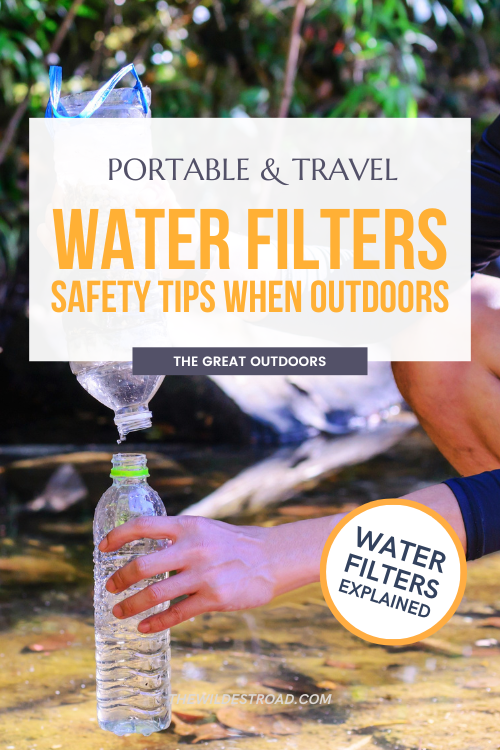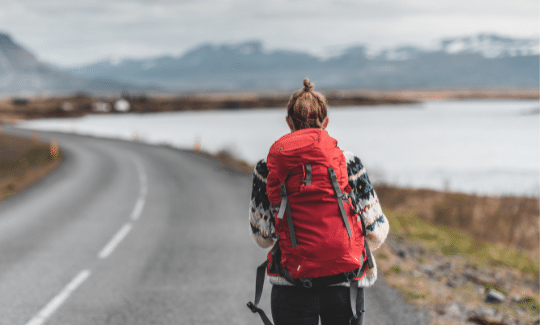Travel Water Filters Explained: Water Safety Tips
During our travels we sometimes find ourselves in locations that lack safe drinking water, and it is for this reason that we always carry a reliable water filter with us.
Water-borne pathogens are the cause of some of the most common and dangerous diseases that travellers face, and are a subject that should not be taken lightly.
To help you understand how to stay safe and have a reliable access to drinking water wherever you are, we’ve listed our top tips and info that we’ve gathered about water filters during our travels!
# How does a water filter work?
The way water filters work can be broken down in three types:
Physical Filters:
Most water filters meant for hiking and camping force the water through a a network of membranes that trap harmful bacteria, protozoans and parasites, as well as sediment such as sand and dirt. Because bacteria and protozoans account for the majority of water-borne diseases in the western world, a physical water filter is a must-have.
Chemical Filters:
While physical filters will trap microorganisms, they’ll do nothing when it comes to viruses, as they are small enough to pass through. Adding a water disinfectant will take care of this issue, as will boiling the water for at least one minute.
Keep in mind: When I say boiling the water, I mean a rolling boil, not just one minute on the stove.
Dangerous toxins and heavy metals are another danger that can be present in water sources, especially when close to factories, inhabited centres or areas with high levels of pollution. For this you’ll need an activated charcoal filter, as it will absorb most toxic elements from the water.
Keep in mind: An activated charcoal filter can only absorb a limited amount of specific types of toxins. If you suspect that the source you’re collecting water from is too polluted to be safe, do not take any chances.
UV Filters:
UV filters use ultraviolet light to destroy all pathogens (bacteria, protozoans, parasites and viruses) that might be present in your water.
They are one of the fastest and most reliable ways to purify water, and are much safer for your health since they don’t rely on any chemicals.
With that said, UV filters do have a few disadvantages:
The water needs to be really clear, as any particles floating in it will block the UV rays from reaching all microorganisms. For this reason, it’s best to pair this system with a physical filter.
While UV rays will kill any pathogens, they will not remove dangerous chemicals that might be in the water.
UV filters are battery powered, so you’ll need to be able to recharge them regularly. It goes without saying that they are also more fragile compared to a simple plastic filter.
We’ve been super happy with this lightweight and easy-to-use Katadyn Water Filter | © Outzer
# When should you use a water filter?
You should never take any risks when it comes to water-borne illnesses.
Here are the water sources for which we would definitely use a filter:
Ponds
Stagnant water is never safe for drinking without being filtered or boiled. However, especially when in natural reserves, ponds are less likely to be polluted with dangerous chemicals.
Lakes
As with ponds, lake water is not safe to drink. A physical filter should be sufficient, but be careful if there are any towns or businesses close to shore. If that’s the case you might need a chemical filter as well.
Streams
While fast moving water is generally considered safer, this also depends on where the stream is flowing through.
If you’re in the absolute middle of nowhere, chances are that the water will be safe to drink. Fast moving water is also much colder, making it less likely for pathogens to survive.
That said, you never know what might be upstream from you. Perhaps a farm or a pasture, with animals doing their business in the water you’re about to drink. Or even worse, other hikers.
For peace of mind, you should still use a physical filter to make sure the water is 100% safe.
Rivers
Unlike streams, never take your chances when it comes to rivers. Always filter the water, and use a chemical filter if you’re worried or unsure about the levels of pollution.
# Extra Safety and Tips
- Most filters claim a 99.99% removal of bacteria and protozoans. While true for the most part, keep in mind that there is always a chance that something might slip through.
- Every filter has a limited volume of water it can clean before needing to be replaced. This value varies, and is usually indicated on the package.
- Don’t forget to regularly clean your filters after you’re done using them. This will prevent mold and other organisms from contaminating and damaging them, which will decrease their life-span.
- Never, ever drink water from areas with poor water hygiene, especially in poverty-stricken regions of Africa and Asia. Even with a filter, poor sanitation greatly increases the chances of catching a life-threatening disease such as cholera, typhoid fever or dysentery. If you have no other choice, be sure to boil the water first.
- If you’re visiting areas with poor hygiene, avoid all uncooked foods that might have come in to contact with unfiltered water. Avoid raw vegetables and shellfish in particular, as those are the most likely to be contaminated by pathogens such as Salmonella and E.coli.
- If you’re unsure about the water quality, only drink from sealed bottles.
And there you have it!
By following these simple tips you’ll drastically reduce your chances of making yourself and your travel companions sick, which is sure to make the trip more enjoyable for everyone.
Did you enjoy this article?
Feel free to save or pin this image so that you can always look back on this blog post!
Stay safe, and we’ll catch you on the road! Until next time this is Luca, signing off.









If there is one thing that can never miss in our packs is a good water bottle. Doesn’t matter if we’re on a relaxing city trip or headed for the deepest jungle, staying hydrated is important, and so is the quality of our water bottles!